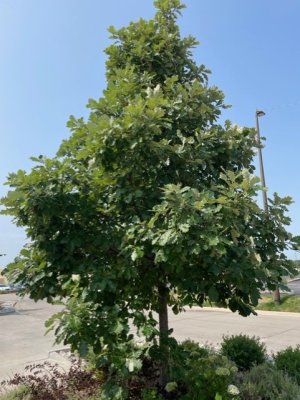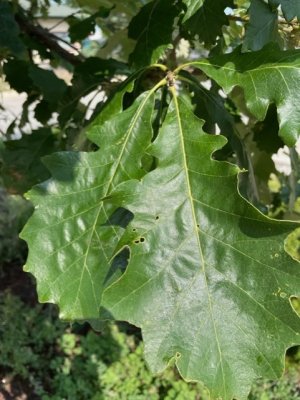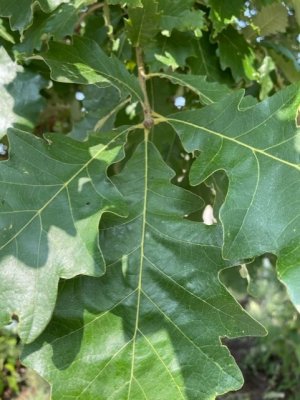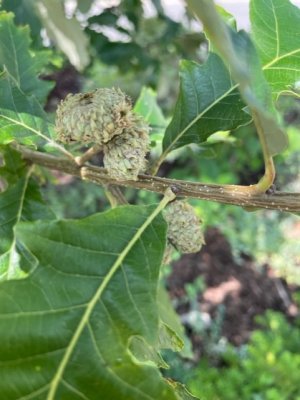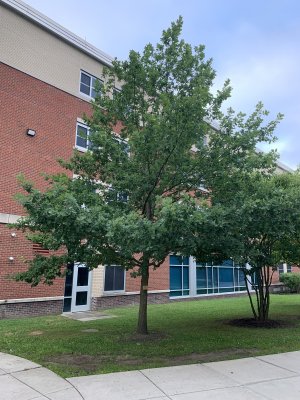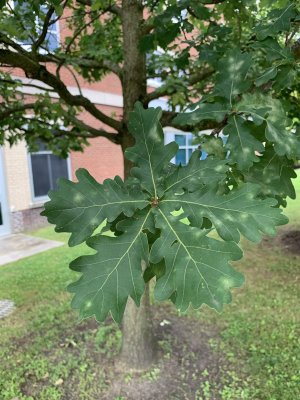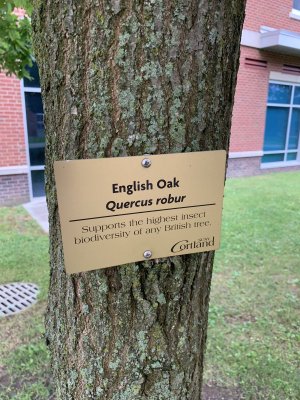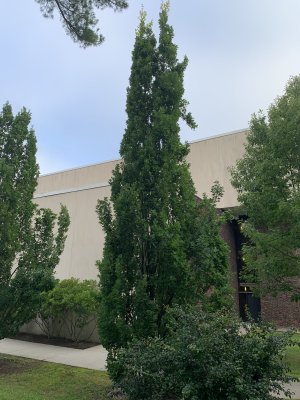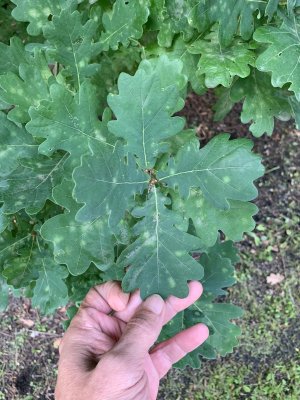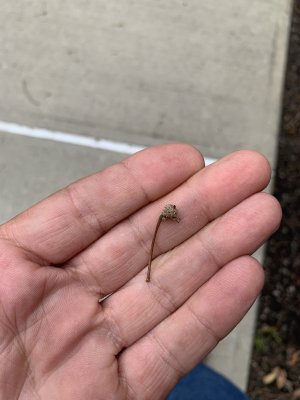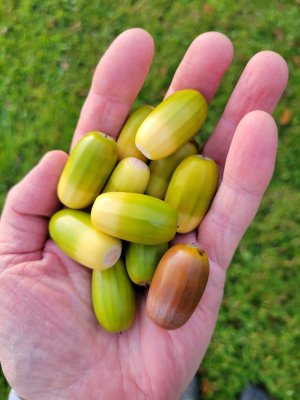-
If you are posting pictures, and they aren't posting in the correct orientation, please flush your browser cache and try again.
Edge
Safari/iOS
Chrome
You are using an out of date browser. It may not display this or other websites correctly.
You should upgrade or use an alternative browser.
You should upgrade or use an alternative browser.
The Woods ... mistakes I'v made
- Thread starter OakSeeds
- Start date
A couple of folks have indicated an interest in locating hybrid oak acorns; I thought I might be able to share some from my sources; however, my area is currently experiencing a severe drought ... only a quarter inch of rain in last 65 days. It appears most nut trees will abort.
Consequently, the next best thing I can do to assist others in their search is to share a great list of locations for collections of oak trees where one might go to collect acorns.
Hope it helps you folks searching for acorns ...
https://www.publicgardens.org/progr...etwork/collections-showcase/quercus-multisite
Be sure to ..... Download Quercus Group Master List 03-29-2017 updated.pdf ..... it's outstanding!
Consequently, the next best thing I can do to assist others in their search is to share a great list of locations for collections of oak trees where one might go to collect acorns.
Hope it helps you folks searching for acorns ...
https://www.publicgardens.org/progr...etwork/collections-showcase/quercus-multisite
Be sure to ..... Download Quercus Group Master List 03-29-2017 updated.pdf ..... it's outstanding!
Last edited:
As I left the parking lot of the restaurant where we enjoyed breakfast after church, I noticed a specimen oak tree on a corner of the parking lot. A slow roll by revealed acorns on the tree; naturally that required a closer inspection .. much to the wife's chagrin. Heck, I've jumped out of the car to check trees in vary public places and people's back yards. You have to be there to see her slink down in her seat.
At any rate, this tree bears watching; it is very young to be spitting acorns. It clearly has bur oak chartacteristics in terms of leaf shape and early acorn development and limb attachment. I'm interested in the early fruiting aspect (it's age ) and the possibility it might be a hybrid with a vigorious growth habit. Only time will tell; I'll share what I observe. Attached are some photos.
At any rate, this tree bears watching; it is very young to be spitting acorns. It clearly has bur oak chartacteristics in terms of leaf shape and early acorn development and limb attachment. I'm interested in the early fruiting aspect (it's age ) and the possibility it might be a hybrid with a vigorious growth habit. Only time will tell; I'll share what I observe. Attached are some photos.
Attachments
Teeder, unfortunately, the answer is no. Given the leaf shape, I thought the only species other than bur oak (obviously planty of bur oak markers) that might play a role in fast growth/fruiting might be swamp white oak. We'll see what everything looks like come late Oct. Thanks for the question. There is another part to this story; however, the photo that tells it all didn't make it onto my computer. I'll have to take another photo and post the rest of the story later in the week. I hope you like it.
Attached is the photo that I couldn't up;load on Sunday; if you look closely you will see a tree in the background - between the 2 Regal Prince trees in the foreground. As you and others probably know, the Regal Prince trees are a hybrid cross between a SWO X English oak. I know the tree in the background is largely bur oak ... it is about 18 yds SW of 4 magnificent Regal Prince hybrids (see May 29 / #276 post above). Since white oak trees are largely wind pollinated and, with our prevailing winds out of the southwest, it seems to me that this situation might be ripe (if I'm lucky) for a 3-way cross (swo X English X bur oak). All 5 trees are throwing acorns this year; however we are in a severe drought situation so I don't expect high volume or large size acorns. I may try my hand at hand pollinating each species with the other. I have no idea what the odds of success are; however (I suspect they are low), I am curious enough to take a shot at it. I'm also going to consult some experts. This post reflects another thing I did wrong .... paying too much attention to the 4 larger trees which led me to overlook the important 5th tree about 50 ft away. Since these are specimen/sidewalk trees in a commercial setting, I doubt anyone planted them in this configuration with the hope/expectation of a hybrid cross. The point is ... if you find a good tree, look around and be aware of what other trees may be in the immediate vicinity.
The leaves on the left are from Regal Prince (swo X English oak) and the leaves on the right side of the photo are from the mystery tree (hoping for a hybrid bur x maybe a swo). The mystery tree clearly has acorns reflecting bur oak parentage; further, the tree does not exhibit the "peeling" bark on the trunk often characteristic of young swo trees. Leaf shape (especially the top half of the larger leaves / mystery tree) and leaf color (verry light ... but probably a weak marker) is what gives me hope there is some swo in it's heritage.
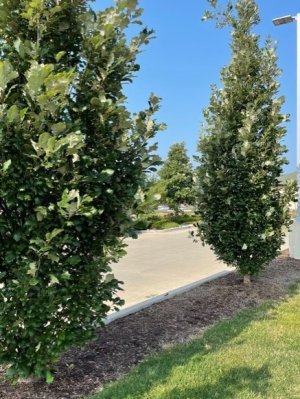
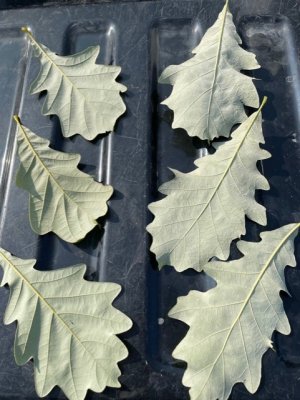
The leaves on the left are from Regal Prince (swo X English oak) and the leaves on the right side of the photo are from the mystery tree (hoping for a hybrid bur x maybe a swo). The mystery tree clearly has acorns reflecting bur oak parentage; further, the tree does not exhibit the "peeling" bark on the trunk often characteristic of young swo trees. Leaf shape (especially the top half of the larger leaves / mystery tree) and leaf color (verry light ... but probably a weak marker) is what gives me hope there is some swo in it's heritage.


Last edited:
Teeder
5 year old buck +
These certainly look a lot like my schuette's leaves.As I left the parking lot of the restaurant where we enjoyed breakfast after church, I noticed a specimen oak tree on a corner of the parking lot. A slow roll by revealed acorns on the tree; naturally that required a closer inspection .. much to the wife's chagrin. Heck, I've jumped out of the car to check trees in vary public places and people's back yards. You have to be there to see her slink down in her seat.
At any rate, this tree bears watching; it is very young to be spitting acorns. It clearly has bur oak chartacteristics in terms of leaf shape and early acorn development and limb attachment. I'm interested in the early fruiting aspect (it's age ) and the possibility it might be a hybrid with a vigorious growth habit. Only time will tell; I'll share what I observe. Attached are some photos.
That would be a great cross with the regal prince!
The Fishman
5 year old buck +
There is Facebook group called International Oaks with lots of Quercus experts. They are very knowledgeable and might be able to help identify the mystery oak. They also may be able to help you in your pollination efforts.
Actually, I am a member; it's offical home is about 80 miles from me in Petersburg IL. Thanks for the heads up ... others may want to explore the IO site.There is Facebook group called International Oaks with lots of Quercus experts. They are very knowledgeable and might be able to help identify the mystery oak. They also may be able to help you in your pollination efforts.
Troubles Trees
5 year old buck +
I am by no means an expert on Oaks, but those look a lot like the English Oaks we have on campus for landscape trees. Ours produce a nut but it has no wildlife value because they are tiny, the squirrels don't touch them but something like Turkey might if they roamed campus. I only call them English Oaks because that is what came up on my tree identifier app said they were. We have labeled trees here too and there is one that has a similar leaf but grows wide like a regular Oak and the plaque says "English Oak".Attached is the photo that I couldn't up;load on Sunday; if you look closely you will see a tree in the background - between the 2 Regal Prince trees in the foreground. As you and others probably know, the Regal Prince trees are a hybrid cross between a SWO X English oak. I know the tree in the background is largely bur oak ... it is about 18 yds SW of 4 magnificent Regal Prince hybrids (see May 29 / #276 post above). Since white oak trees are largely wind pollinated and, with our prevailing winds out of the southwest, it seems to me that this situation might be ripe (if I'm lucky) for a 3-way cross (swo X English X bur oak). All 5 trees are throwing acorns this year; however we are in a severe drought situation so I don't expect high volume or large size acorns. I may try my hand at hand pollinating each species with the other. I have no idea what the odds of success are; however (I suspect they are low), I am curious enough to take a shot at it. I'm also going to consult some experts. This post reflects another thing I did wrong .... paying too much attention to the 4 larger trees which led me to overlook the important 5th tree about 50 ft away. Since these are specimen/sidewalk trees in a commercial setting, I doubt anyone planted them in this configuration with the hope/expectation of a hybrid cross. The point is ... if you find a good tree, look around and be aware of what other trees may be in the immediate vicinity.
The leaves on the left are from Regal Prince (swo X English oak) and the leaves on the right side of the photo are from the mystery tree (hoping for a hybrid bur x maybe a swo). The mystery tree clearly has acorns reflecting bur oak parentage; further, the tree does not exhibit the "peeling" bark on the trunk often characteristic of young swo trees. Leaf shape (especially the top half of the larger leaves / mystery tree) and leaf color (verry light ... but probably a weak marker) is what gives me hope there is some swo in it's heritage.
View attachment 55054View attachment 55070
I will try to take pictures today if I make it on the hill.
Troubles Trees
5 year old buck +
Troubles Trees
5 year old buck +
Teeder
5 year old buck +
One comment about tree ID aps. I use "picture this" and it can't identify hybrids. For example, my schuette's will be labeled as swamp white or bur, depending on which leaf I take a picture of.
I have a couple trees that I thought were english, but appear to have "white" in them. The ap only sees english.
I have a couple trees that I thought were english, but appear to have "white" in them. The ap only sees english.
The Fishman
5 year old buck +
Those acorns don't look fertilized. That is why they are so small.
TT photos are all English oaks; however, the 1st tree is a common Eo with full "spreading" canopy or crown. You'll notice the left side of the tree is not filled out as much as the right side; the tree is probably planted too close to the building. Photos 4,5, and 6 are columnar E-oaks with the typical dull looking leaves I encounter on most English oaks (not on the hybrids like Regal Prince with swo parent). Crimson Spire - a hybrid cross between a Col. English oak and a white oak frequently has discolored leaves ... sometimes due to powdery mildew. I believe the acorn in photo 7 is an aborted acorn ... likely off of one of the columnar trees. Teeders acorns are EO's .... still green ... they will eventually turn brown and shrink down a bit to reveal ridge lines on the acorn (the lines exist on his acorns but they are not very distinct).
Last edited:
Another hybrid involving the columnar English oak is the cross between the English oak X straight white oak (Eo X WO), one variety is called the Crimson Spire. I watch 2, 7-tree lines of this hybrid, one on oval medians in a parking lot and the second on the entry way to a subdivision. Each 7-tree planting is different in a couple of ways; first, the trees in the entryway have all held their leaves throughout the entire winter for the last two years while the trees in the parking lot lose almost all their leaves by Xmas. The second differing item involves the rate of aborted acorns. The parking lot trees have aborted 95-98% of their acorns for each of the past 4 years (see photo 1). And while the subdivision trees also abort some acorns, the numberr is much smaller and the phenomenon occurs earlier in the acorn growth cycle with the smaller aborted acorns remaining on the tree (photo 2 ) instead of falling on the pavement. Photo #3 displays an aborted acorn - remaining on the tre - next to a developing acorn. From my limited experience with this variety of white oak hybrid, I wonder whether it would be very valuable as a mast tree.
The white oak genetic influence is readily apparent in the leaf shructure and the smooth caps on the acorns, I find it interesting that the acorns from the hybrid seem to always exhibit more of the gumdrop shape instead of an elongated shape like that of an English oak or a white oak. The acorns in the 2 photos below are more elongated than most gumdrop-swamp-white oaks I gather.
see photo below ...
The white oak genetic influence is readily apparent in the leaf shructure and the smooth caps on the acorns, I find it interesting that the acorns from the hybrid seem to always exhibit more of the gumdrop shape instead of an elongated shape like that of an English oak or a white oak. The acorns in the 2 photos below are more elongated than most gumdrop-swamp-white oaks I gather.
see photo below ...
Last edited:
Similar threads
- Replies
- 16
- Views
- 2K

